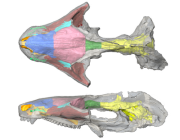
Catherine Musinsky has served as Dr. Crompton's technical assistant, editor, illustrator, and research assistant for over 25 years. What started as a "day job" to support a professional dance career turned into a lifelong commitment and fascinating journey. Catherine performs CT scanning, 3D reconstruction and segmention of extant and extinct animals. She runs experiments, edits, illustrates, and now co-authors his publications. Catherine has a BA from Harvard College, a MFA from Tisch School for the Arts, and a ALM in Digital Media from Harvard Extension School.

